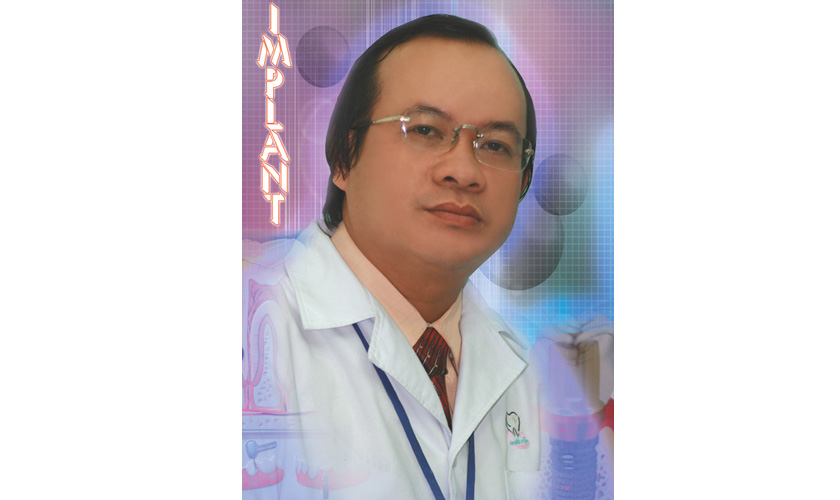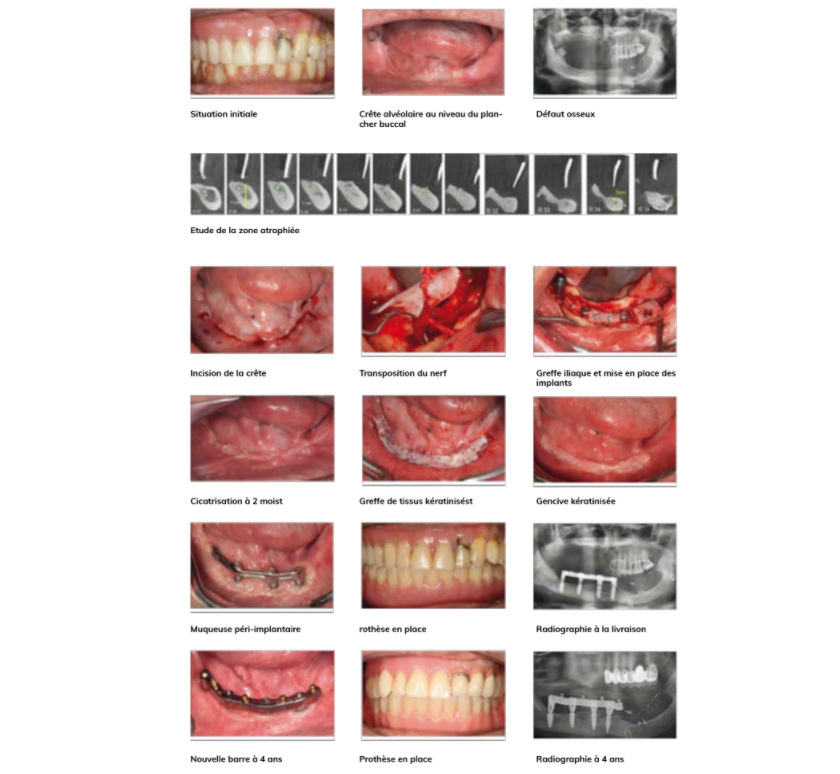Transposition nerf alvéolaire: Résultats 4 ans

Transposition du nerf alvéolaire inférieur en vue d’une rehabilitation implantaire - Résultats à 4 ans
Dr. Vo Van Nhan (Vietnam)
Un patient de 59 ans présente un important défaut osseux suite à l’impact d’une balle d’arme à feu il y a 40 ans. Sa complainte majeure est la difficulte à manger avec la prothèse conventionnelle réalisée suite à l’incident.
L’examen intra-oral révèle une perte osseuse mandibulaire importante, la crête alvéolaire se situant au même niveau que le plancher de la cavité buccale. On note également l’absence de gencive kératinisée. L’analyse radiologique montre que le nerf inférieur traverse la ligne médiane oblique à proximité de la crête alvéolaire et se trouve même exposé en position 41, 31. La hauteur d’os résiduelle est de 7 à 11 mm. Dans cette situation, il est impossible de réaliser une apposition osseuse ou bien d’envisager une restauration type « All on 4 ».
Notre décision est de transposer le nerf alvéolaire et de combiner cette opération avec une greffe iliaque d’augmentation verticale suivi du placement simultané de 4 implants In-Kone®. Nous obtenons une bonne stabilité primaire à la pose (supérieure 35 N.cm). 2 mois plus tard, nous réalisons une greffe muco-conjonctive et une vestibuloplastie pour améliorer l’environnement muqueux péri-implantaire et relâcher le tissu conjonctif sur la crête alvéolaire.
Une barre avec des attachements est confec- tionnée. Cependant, à 4 ans, la prothèse est instable et peu retentive à cause de l’usure des attachements. Une nouvelle barre munie d’at- tachement Equator (Rhein 83) est conçue. Une bonne ostéo-intégration est observable autour des implants, sans perte osseuse constatée à 4 ans. Le patient est satisfait par sa prothèse qui lui a permis de retrouver une fonction masticatoire améliorant ainsi significativement sa qualité de vie.
Inferior alveolar nerve transpositioning for dental implant rehabilitation - 4-year results
A 59-year-old male presented jaw bone defect caused by gunshot that iliac block bone graft was done 40 years ago. His chief complaint was unable to eat with the traditional denture he was using over 40 years.
Intraoral examination revealed serious mandi¬bular bone loss so that the alveolar crest was in the same level with the floor of the mouth. No keratinized tissue was observed. Radiograhic diagnosis showed the inferior nerve acrossed the midline and was close to the alveolar crest. It even exposed on the crest in the position 41, 31. The residual bone height was 7 to 11 mm. In such a situation, it’s impossible to perform block bone graft, bone distraction or All on 4.
Our decision was transpositioning inferior al¬veolar nerve in combination with vertical iliac block graft and 4 In-Kone® implants placement simultaneously. Implant obtained good initial stability (> 35N/cm). 2 months later, we carried out free soft tissue graft and vestibuloplasty to improve soft tissue around the implants and loose connective tissue on alveolar crest.
A bar-retained implant overdenture with clip attachment was delivered. However, after 4 years loading, the overdenture was unstable and unretentive as the clip worn out. The new bar-retained overdenture with equator attach¬ment from Rhein’83 system was replaced. Good osseointergation around implants are still maintained with no bone loss after 4 years. The patient is satisfied with the new overdenture that improve significantly his chewing function and aestheic, especially his quality of life.


Bài viết liên quan
- Mất 1 răng hàm có sao không?
- Tác hại của mất răng hàm và giải pháp khắc phục
- Bị mất răng hàm - Nguyên nhân và cách điều trị
- Bảo hành trồng răng Implant tại trung tâm Implant Việt Nam
- Phục hình cầu răng trên trụ implant là gì?
- Trồng răng Implant không đau tại Implant Việt Nam
- Ưu điểm trồng răng trả góp tại Trung tâm Implant Việt Nam
- Tất tần tật những điều cần biết về implant
